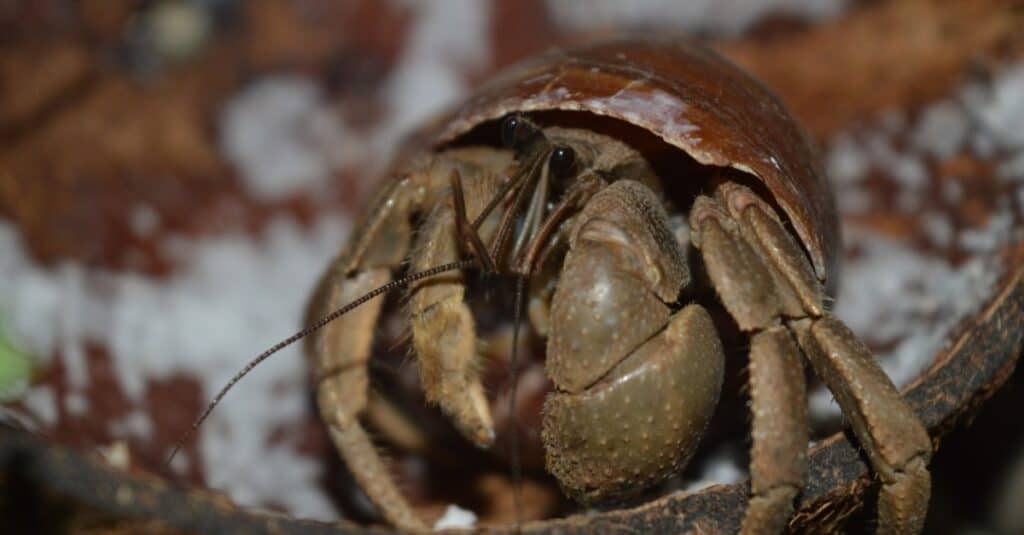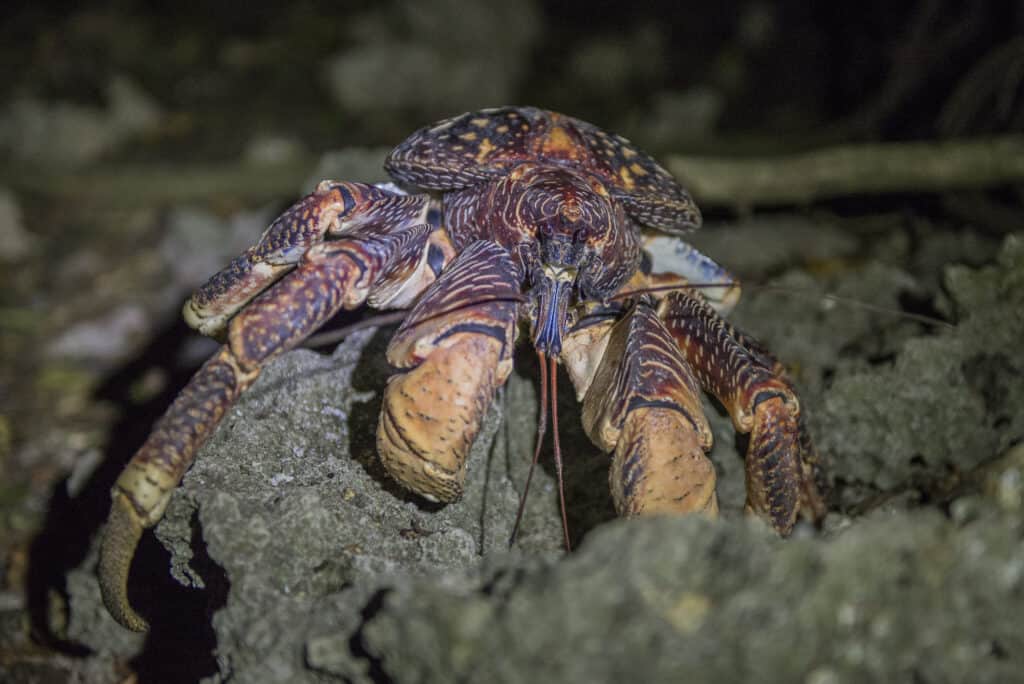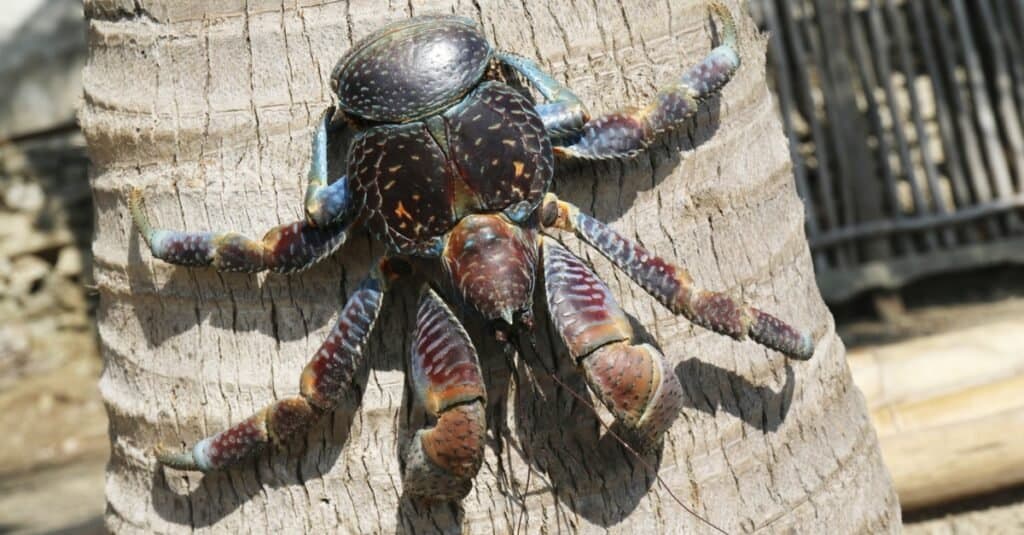While they’re large, fascinating creatures, coconut crabs are fierce predators with the strongest pinch among crustaceans! How do they use this force to get food, and what exactly do they eat? Let’s find out!
What Are Coconut Crabs?

Coconut crabs are sometimes called robber crabs or palm thieves.
©iStock.com/BrianScantlebury
Coconut crabs (or Birgus latro) are the world’s largest terrestrial arthropods! They are terrestrial hermit crabs, sometimes called robber crabs or palm thieves. These crabs inhabit islands across the Indian Ocean and parts of the Pacific Ocean. Some coconut crabs are found near Zanzibar, off the coast of Africa.
Coconut crabs have an average body length of 16 inches and a weight of up to nine pounds! Their leg span is more than three feet – just imagine how big they are!
Coconut crabs have a cephalothorax comprising the head, thorax, and abdomen. They have ten legs:
- The front left leg is larger than the right, and both have large claws;
- The next two pairs are large and strong walking legs that help them climb vertical surfaces;
- The fourth pair is smaller and has claws resembling tweezers;
- The fifth pair is the smallest – males use it for mating and females for tending their eggs.
Most coconut crabs are blue, while some can be red or purplish-blue. Their color depends on where they live.
The coconut crab’s abdomen protects them and reduces water loss on land.
What Do Coconut Crabs Eat?

Coconut crabs eat fruits, seeds, drupes, nuts, and the pith of fallen trees.
©iStock.com/jamechi
Coconut crabs are omnivores. They primarily eat fruits, seeds, drupes, nuts, and the pith of fallen trees. Here’s a list of specific things they can eat:
- Flowering plants called Ochrosia ackeringae
- Lister’s palm
- A tropical plant called Pandanus elatus
- Candlenut
- Coconut
- Custard apples
Besides these, coconut crabs will also eat tortoise hatchlings, dead animals, and other crabs, including Christmas Island red crabs and Discoplax hirtipes crabs. Moreover, they’re capable of killing Polynesian rats! Some large coconuts may even feed on birds. One was spotted feeding on a red-footed booby.
How Do Coconut Crabs Open Coconuts?
While opening a coconut may sometimes be pretty challenging for humans, it’s a piece of cake for coconut crabs.
Some coconut crabs take the coconut, climb a tree up to 33 feet high, then drop the coconut. After this, they often fall from the tree to delight in the coconut flesh. No worries, coconut crabs are immune to falling from heights of up to 15 feet, so no crabs get hurt during this procedure!
They use their large pincers with serrated edges, commonly known as teeth, to cut holes into the coconuts and eat the flesh.
How Do Coconut Crabs Find Food?

Coconut crabs have a very keen sense of smell that works differently underwater and on land.
©iStock.com/Riccardo Maywald
Coconut crabs have a very keen sense of smell that works differently underwater (where they smell hydrophilic molecules) and on land (where they smell hydrophobic molecules). In water, coconut crabs use their aesthetascs (organs used to determine the direction and concentration of smell) on their antennae. Land coconut crabs’ smell systems are similar to those of insects, meaning they flick their antennae to enhance their smell.
Do Coconut Crabs Have Predators?
Coconut crabs have no known animal predators. Humans are their only predators. On populated islands, the coconut crab population is almost extinct because people hunt them for their meat, which is considered a delicacy. Some parts of the world even use coconut crab meat as an aphrodisiac!
Do Coconut Crabs Eat Human Flesh?
While coconut crabs aren’t generally aggressive, they’ll defend themselves if they feel threatened. Since humans are their only predators, coconut crabs can use their pincers to hurt them. Some people have mistakenly put their fingers in a coconut crab’s burrow and gotten attacked.
However, would they really eat people? A single crab would probably be unable to eat a whole human being. Even if they like human flesh, they’ll need more of their kind to kill a person.
If you’re reading this article, you’ve probably already heard about Amelia Earhart, who was supposedly torn apart by coconut crabs. She was a female aviator who disappeared in 1937 in the Pacific Ocean. A fractured skeleton was found three years later, and experts believed coconut crabs did the job.
However, it’s still a mystery whether that body belonged to Amelia Earhart and whether coconut crabs did the damage. While some studies show that the bones belonged to a male, others demonstrate that it’s highly likely they belonged to Amelia Earhart.
So can coconut crabs eat human flesh? Yes, in theory, they could eat human flesh, but it’s highly unlikely they’ll ever get to do that.
Can You Eat Coconut Crabs?

Coconut crabs aren’t considered poisonous to humans.
©KYTan/Shutterstock.com
Coconut crabs are considered a delicacy. However, if you decide to try their meat, you should know that you may get food poisoning. Poisoning cases from eating coconut crabs have been reported.
While coconut crabs aren’t considered poisonous to humans, their diet while alive might’ve included foods that are poisonous to people. Poisoning cases from eating coconut crabs have been reported.
Moreover, because their population is currently listed Vulnerable, avoiding their consumption is recommended, thus discouraging their hunting.
Incredible Coconut Crab Facts
- Coconut crabs are sometimes called robber crabs. This name comes from their ability to steal things. In the 20th century, several scientists noticed coconut crabs stealing things, even a bottle of whiskey! Experts think this has to do with their keen sense of smell.
- Coconut crabs have the strongest pinch among crustaceans! A coconut crab weighing 9 pounds has a crushing force of 3,300 newtons. In contrast, lobsters have a claw strength of only 150 newtons.
- Coconut crabs are solitary animals living in their burrows. They don’t communicate even when they look for food. On the contrary, they have a claw-waving sign that announces their presence so that other coconut crabs keep their distance. If another coconut crab enters their homes, they’ll likely kill and eat it.
- Coconut crabs can live up to 60 years!
Up Next:
- The 10 Largest Crabs in the World
- 10 Incredible Hermit Crab Facts
- Hermit Crab Poop: Everything You’ve Ever Wanted to Know
The photo featured at the top of this post is © KYTan/Shutterstock.com
Sources
- Treehugger, Available here: https://www.treehugger.com/coconut-crab-facts-5179404
- Untamed Animals, Available here: https://untamedanimals.com/can-you-eat-coconut-crabs/
- National History Museum, Available here: https://www.nhm.ac.uk/discover/coconut-crabs-bird-eating-giants-on-tropical-islands.html
Thank you for reading! Have some feedback for us? Contact the AZ Animals editorial team.







